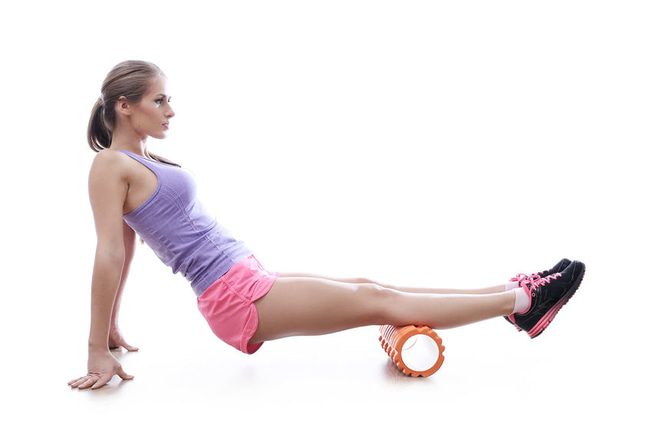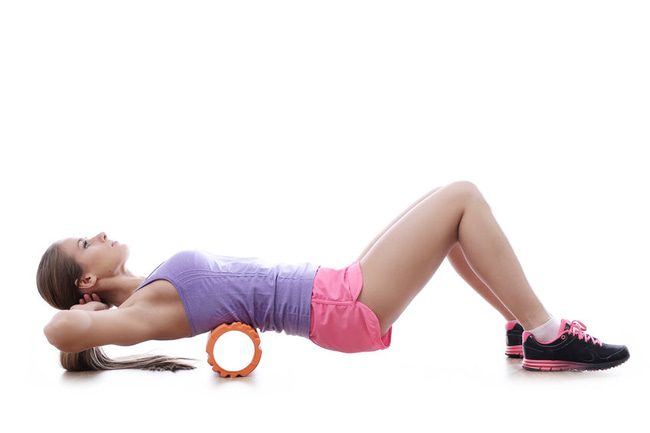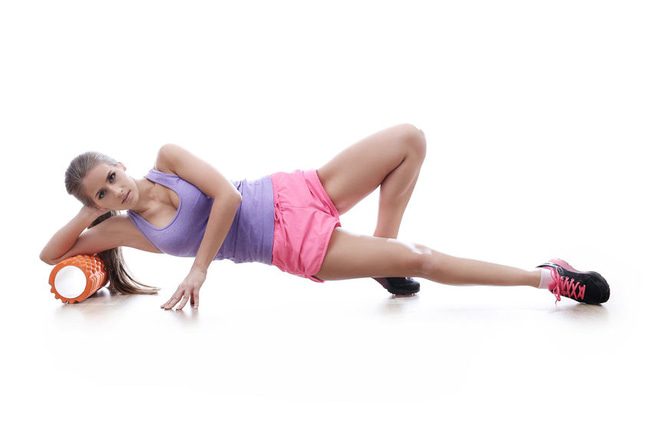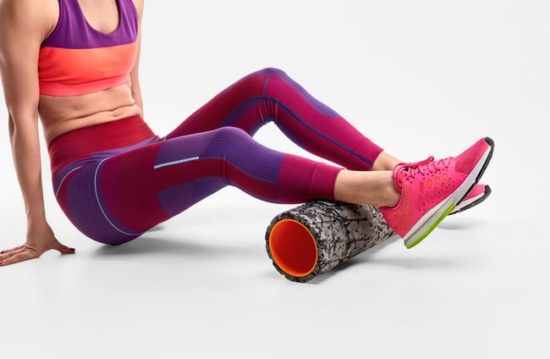Whether you should foam roll before or after a workout is a great question and one I will answer in today’s article. I will not only explain when to foam roll for maximum benefits but also how to foam roll correctly before and after exercising and how they differ. After all, there is no reason you can’t do both, provided you perform the rolling properly.
As recently as a decade ago, many coaches and personal trainers were skeptically about foam rolling. Over time, however, foam rollers have earned their place as a standard tool used by many athletes and fitness enthusiasts. Foam rolling has been proven to increase your range of motion and help reduce pain and stiffness before, during, and after your workout.
However, knowing how and when to foam roll is important if you want to get the most out of this simple but effective tool.
Some opinions vary when it comes to the benefits of foam rolling before a workout, though most would agree that rolling after a workout has many positive benefits.
I will show you how both can be very beneficial for different reasons.
TABLE OF CONTENTS
- What Are Foam Rollers Used For?
- Should You Foam Roll Before or After a Workout?
- How to Foam Roll Correctly Before and After a Workout
- Rolling Before a Workout for Performance
- Rolling After a Workout for Recovery
- Additional Considerations
What Are Foam Rollers Used For?
A foam roller, as its name implies, is a cylinder-shaped roller on which you can lay in various positions and ultimately use your own bodyweight to put focused pressure on problem areas to break up fascia and knots, or just loosen up muscle tissue before a workout.
Fascia is a thin tissue that connects human muscles and helps them work as integrated units. In a healthy person, fascia is supple, flexible, and glides smoothly. However, fascia can bind up for numerous reasons, such as trauma, injury, inflammation, disease, and most commonly, inactivity. Even sitting at a desk all day can cause your fascia to become stiff and what personal trainers refer to as “gummed up.”
You can roll your hamstrings, glutes, quads, and even muscles in your shoulders, hips, and back. This allows areas that are tense and stiff to re-establish their former integrity, which can only lead to more successful workouts and better physical fitness.
Various Types of Foam Rollers
I have found various types of foam rollers available on the market today. You can find rough and smooth textured rollers, or high-density and low-density foam rollers. You also have foam rollers that can collapse for better portability and storage. Or even your high intensity vibrating foam rollers.
Should You Foam Roll Before or After a Workout?
So, should you foam roll before or after a workout? Let’s take a closer look at the many benefits both have to offer. Who knows, perhaps both could be very useful to you for various reasons.
When To Foam Roll Before a Workout & The Many Benefits

Once thought of as a technique that should only be used after a workout, most experts and personal trainers now realize there are considerable advantages associated with foam rolling before exercising as well. It is simply a matter of understanding that the approach and ultimate objectives are different, depending on whether you are foam rolling after a workout or before you begin. Some of the advantages associated with foam rolling prior to a workout include the following:
Increases Blood and Oxygen Flow
Foam rolling increases blood circulation and oxygen flow to the muscles. This is because applying force to your connective tissues supplies them with a fresh flow of blood. Because blood carries vital nutrients, such as glycogen and oxygen to muscles, boosting this blood flow before exercising helps you to work out more efficiently from the moment you begin.
Helps Your Body Lubricate its Joints
Your muscles can be in excellent shape, but if your joints are stiff, workouts become a tedious and uncomfortable process. The combination of the mechanical pressure and the heat generation produced by foam rolling causes joint fluid to become thinner. When this fluid thins out, it ultimately becomes more efficient. This, in turn, decreases friction resistance during your workouts. If you think of how oil affects a metal joint, it is essentially the same thing.
Provides an Ideal Warm-Up
Virtually every fitness conscious person understands the importance of warming up before exercising. Foam rolling is an outstanding addition to your warm-up, as it has similar benefits to that of a deep tissue massage, which can only improve the flexibility of your muscles and connective tissues.
Enhances Range of Motion
Because of the aforementioned heat generation and mechanical pressure associated with foam rolling, you can typically expect to have a greater range of motion in your joints when you begin your workout. This is an important benefit, as it can help to prevent injury and increase your stamina, regardless of the type of exercise routine you complete.
Loosens Muscle Tissue
Stiff muscles cause many people to cut their workout short and subsequently lose out on myriad benefits. Foam rolling is one of the quickest and easiest ways to loosen muscle tissue prior to a workout, which gives you a head start as you dive into your routine. The activity generates a quick response in your body and speedily gets you to a stronger position from which to begin your workout.
Increases Oxygen Flow
If you are like many fitness conscious individuals, at least some of your workout focuses on strength and endurance training. The number one way to enjoy better performance with regard to strength training is to increase the flow of oxygen to your muscles. This is precisely what foam rolling does, making it a highly beneficial activity prior to a workout.
Timing Before A Workout
You may be asking yourself how soon before your workout should you foam roll? The best answer is just before you begin your exercise session. This is because your muscles are still loosened and warmed up from your rolling routine, which helps ease you into your workout at top efficiency.
When To Foam Roll After a Workout & The Many Benefits

Some of the advantages associated with foam rolling after a workout include the following:
Enhances Recovery
Virtually everyone who exercises on a regular basis desires the speediest recovery possible after their workout. Working out before proper recovery has taken place is counterproductive. Nevertheless, if you are like most people, you don’t like waiting too long between routines. For this reason, you will be pleased to know that foam rolling after a workout expedites the recovery process and ultimately allows you to enjoy greater benefits from your exercise session.
Soothes Sore Muscles
Sore muscles are part of anyone’s physical fitness routine and there is no way to entirely avoid a few aches and pains after a good workout. However, foam rolling after your exercise session is a great way to significantly decrease soreness the following day.
Loosens and Relaxes Tight Muscles
Like most people, you probably exercise to the limit of your endurance in order to enjoy the best possible results. Unfortunately, this can often lead to tight muscles after your routine is complete. This usually manifests approximately two to six hours following your workout and can be particularly bothersome the next day as well. As you know, tight muscles are painful and irritating. Foam rolling after exercising can go a long way toward eliminating this post-workout predicament.
Timing After A Workout
Now you are probably asking yourself the same question you did concerning foam rolling before your workout: how soon after your workout should you foam roll? Unlike rolling prior to exercising, this activity does not have as tight a deadline when executed after working out. You can foam roll immediately after your exercise routine or just prior to your shower. You may also wish to wait several hours after you work out, or even foam roll as late as bedtime. This decision is largely a matter of personal preference.
How to Foam Roll Correctly Before and After a Workout

The way you execute your foam rolling routine primarily depends on the desired effect you want to achieve. In other words, the activity is performed differently depending on whether your objective is increased performance or recovery benefits.
For example, someone whose main goal is increased oxygen and blood flow to the thigh muscles–such as would be the case with a long-distance runner–typically uses a different routine from that of a bodybuilder, whose goal is to have bigger muscle pumps and more strength. Ultimately, however, the method you use primarily depends on whether you are focused on performance or recovery.
Rolling Before a Workout for Performance
Understanding your main objective helps you use the proper techniques before your workout. For example, if you plan to focus on a specific set of muscles during your exercise routine, only foam roll that particular group of muscles.
You should also avoid the common mistake of spending too much time foam rolling, as this can lead to weakened and fatigued muscles–something you want to avoid when exercising. Don’t fall into the trap of “some is good, so more must be better,” as this is not the case with rolling before a workout. Rather, complete a light rolling routine for the best results.
Try using less intensity and pressure when rolling before your exercise routine. Keep in mind that this is a beneficial warm-up as opposed to your primary workout.
Always remember that your main goal is to loosen your muscles and boost blood circulation to the fascia to ultimately increase your flexibility during your workout.
Rolling After a Workout for Recovery
Do not be afraid to roll more intensely after your workout than you did prior to beginning your routine. This is because your primary objective is recovery, which includes working out tightness and soreness from your muscles. Not surprisingly, this requires more intensity than is necessary when you are simply preparing for a workout.
It is advantageous to complete a longer or deeper session when foam rolling after a workout: it may take a longer session with more intense maneuvers to adequately massage all the muscle groups you used during your workout.
Keep in mind that your primary objective is to prevent post-workout soreness and shorten your recovery time.
Additional Considerations
When it comes to deciding when to foam roll, you may have already come to the conclusion that performing this activity both before and after might be your best course of action. Provided you perform the activity properly, there is no reason to limit yourself to only one or the other.
Finally, do not hesitate to tweak your rolling habits to whatever works best for you.
I have also found that using a vibrating foam roller in place of your traditional foam roller can have many advantages. Some of these advantages include deeper muscle penetration, and less time-consuming as it can stimulate more muscle tissue in half the time. You can find some great vibrating foam rollers here.
As always, discuss any changes in your exercise routine with a fitness coach or healthcare practitioner.

With over 30 years of experience in strength training and fitness, Mark LaRue is the founder of Fitness Mastered, a blog to help educate fitness enthusiasts of all fitness levels, ages, and gender. We write topics that range from weight training tips and exercise routines to home workout machine and fitness related product reviews, to name a few.

